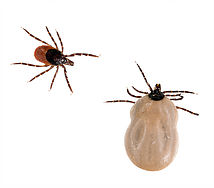It’s tick season again. You may have already noticed clinics around town mentioning the topic or seen somewhere on social media a shared link about them. Instead of a long ramble post describing everything in detail, I thought I’d share a few key facts in point form. Any further questions can certainly be directed to us or your local veterinarian.
– Ticks are small blood-sucking arachnids (Yes, they are related to spiders!) that hide in bushes or grasses, and attach to animals to feed, grow, and reproduce.
– Ticks become active when the temperature rises above 4C, even if there is still snow on the ground
– Higher risk areas for tick exposure are bushy or grassy areas. While most ticks wait for hosts to walk by, some tick species actively seek out and hunt for hosts. Prevention is the best recommendation
1) Avoid high-risk areas
2) Prevention – for people we can use repellents, however for our pets who lick and groom themselves and ingest some of these products this can cause potential toxicities. There are several tick prevention medications that can be used to kill ticks before, or soon after they bite to prevent infestations and infection.
3) Check – yourself and your pets regularly for any new lump/bumps that may be a feeding tick, especially after travelling in higher risk areas. Remove them if found and submit them for testing.
– Ticks may feed for up to several days at a time. Disease transmission takes varying amounts of time depending on the disease, so prompt discovery and removal is important. Tick preventative medications can be used to prevent tick infestations in your pets. Ask your veterinarian about the different options and how they work.
– The province of Alberta has a tick surveillance program that tests ticks for the presence of Lyme disease. Your local veterinarian can submit ticks found on your pets for testing (unfortunately this service does not test for other tick-borne diseases such as anaplasmosis). If found on a person, the ticks must be submitted through your family doctor or your local Alberta Health Services Environmental Health Office.
http://www.health.alberta.ca/health-info/lyme-disease.html
– REMOVAL: If you find a tick on your dog, do NOT squish it, or apply chemicals to it to cause it to let go and die. This will only cause it to regurgitate the blood it has sucked into the bloodstream, potentially increasing the chance of infection should it be carrying a disease. See the link below for the proper removal technique. You may use a tick removal tool or using tweezers to grasp the tick as close to the skin as possible and gently pull straight outwards. Do NOT twist or bend the tick as you are pulling.

